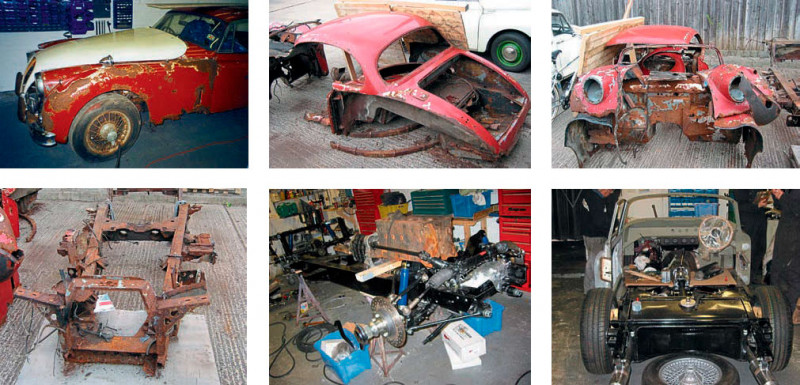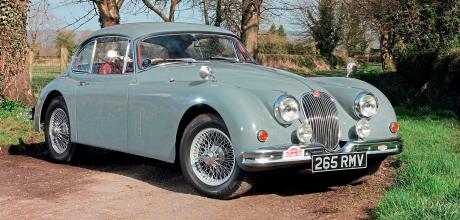Fuel-injected 4.2-litre 1958 Jaguar XK150
Upgraded XK150. Breathing new life into a ’50s sports car courtesy of an injected 4.2-litre engine and all the mod cons including air con.
Even the oldest Jaguar sports cars can benefit from modern upgrades, as this fuel-injected, 4.2-litre XK150 proves.
WORDS & PHOTOGRAPHY ROB HAWKINS
Time Trial Restomod XK 150
Now that the engine has warmed up, you have to push it a little more, just to hear the noise,” comments Jack Pearson of Classic & Sports car Centre near Malton in North Yorkshire. It’s the induction roar from a bank of six Jenvey 45mm throttle bodies to which Jack is referring and he’s right: as I head off behind the wheel of this modernised XK 150 and at the first opportunity, leave the five-speed gearbox in second and allow the engine revs to continue climbing at a steady pace.
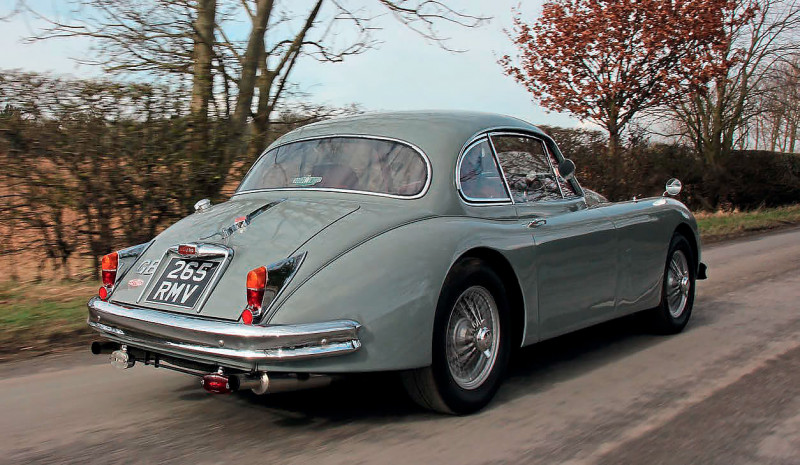
The exhaust system remains quiet and refined, but the induction system eventually erupts into an enthralling gargle that opens your senses to the very modern acceleration provided by what is after all a 1958 car. Those six throttle bodies breathe through a bespoke plenum chamber that’s visible inside the engine bay, although part of it is hidden inside the modified offside inner wing so engaging though it may be, the induction noise is actually not as ferocious as you’d experience from a bank of Webers running mesh filters.
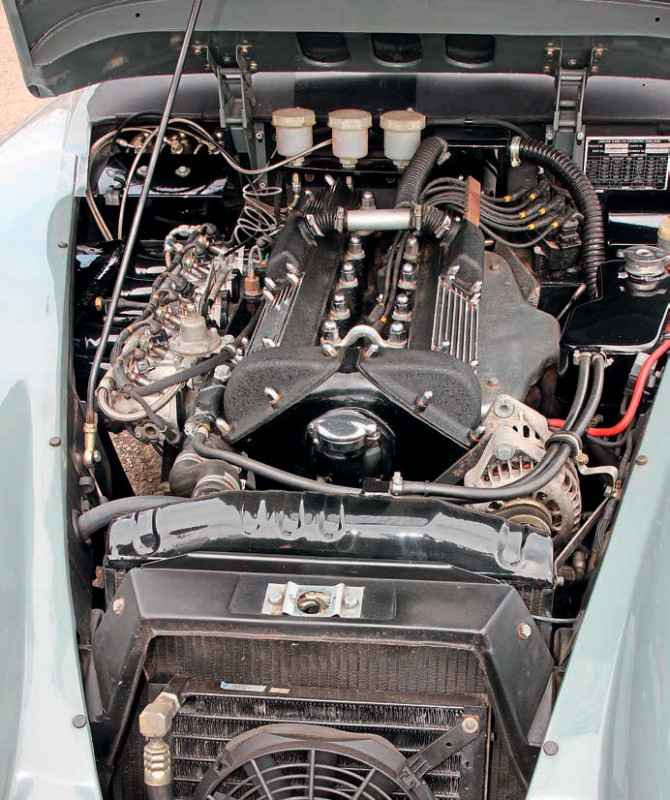
Instead, it’s music to my ears, but at the same time, I need to be aware of the fact that the entertainment value of driving this XK 150 isn’t solely about the induction tunes. As I accelerate hard in second gear, I eventually opt to calmly change up to third gear and notice I’ve already reached 60mph with a couple more gears still in reserve from the all-synchromesh Rover LT77 five-speed gearbox, as used in the 1980s Range Rover, Triumph TR7 and Rover SD1 – ironically, a unit said to have been derived from a Jaguar design originally.
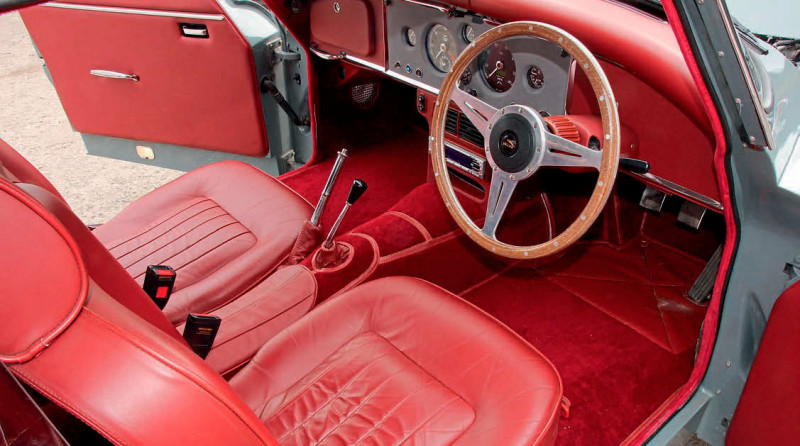
This box has a standard H-pattern for first to fourth gears, with fifth gear offset to the right and reverse requiring a knock of the gearlever over to the left to open the safety lock, before selecting what feels like an elongated first. It’s so straightforward to operate and select gears, although at times, I get it wrong when conducting a three-point turn, selecting first instead of reverse, but there’s thankfully less danger of accidentally doing the opposite, which could be more of a disaster – imagine setting off in queuing traffic in first gear, only to hurtle backwards into the car behind.
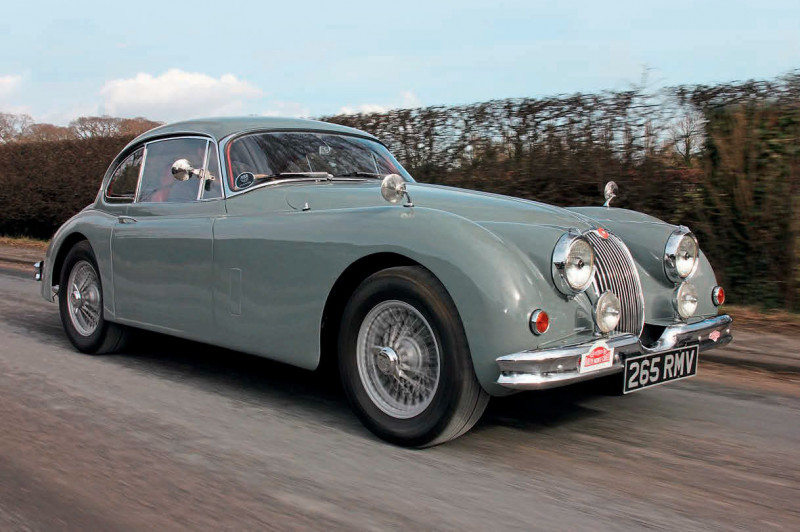
On the move, changing down gears from fourth to third in anticipation of a corner, or from third to second for a turning, is precise and I soon take for granted just how slick the gear selections are with no hint of being notchy or unpredictable. I cautiously avoid changing down from second to first when moving slowly, incorrectly assuming the synchromesh will complain, but eventually have a go and realise I have nothing to worry about.
Another aspect of this XK150 that fills me with confidence concerns the steering and suspension. With power-assisted rack-and- pinion steering (an electric steering pump provides assistance), I’m not left fighting with the steering wheel during slow manoeuvres, but also I’m not wandering from side to side at high speed. And under hard or fast cornering, the steering feels positive and predictable with no hint of vagueness about where I’m heading. The brakes take a little getting used to. Behind the front wheels, there are drilled discs with what appear to be four-pot alloy calipers, whereas the rears have standard twin-piston calipers with a separate mechanical handbrake.
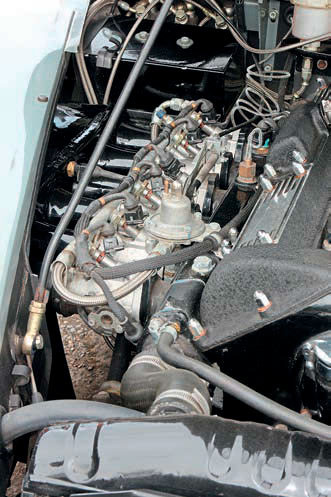
Modern Jenvey throttle bodies provide smooth and reliable electronically controlled fuelling.
Peering inside the driver’s footwell though, I spot there’s a Wilwood pedal for the brake and clutch, with three reservoirs inside the engine bay, so there are separate circuits for the front and rear brakes. I can’t find a brake servo, but under heavy braking, I can hear a distinct noise that sounds a bit like an electric pump. Perhaps there’s an electric brake servo, which uses an electric pump to generate vacuum and top it up when needed, such as under heavy braking.
There is a reason for me being slightly vague about the specification of this XK150 though. Typical of a completed project that was finished roughly 15 years ago and since then had several new owners, the receipts that come with it paint a picture of what has been fitted, but there’s no definitive specification list.
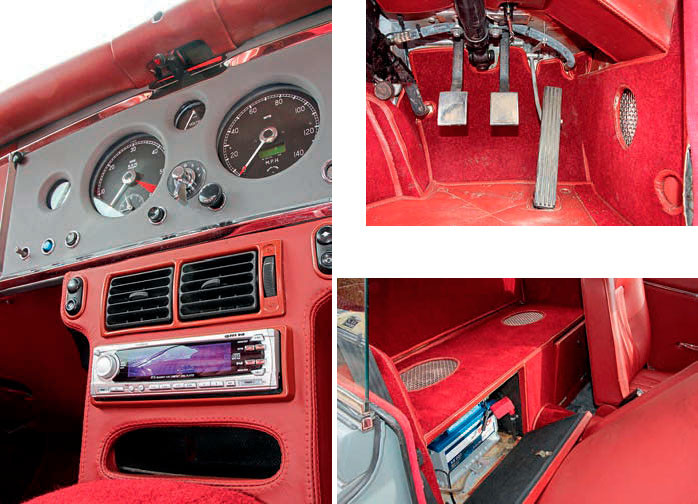
Classic & Sports car Centre do their best to keep all known history for a vehicle they are selling and often see vehicles returned to them to sell again when the owners are ready to move on, so they’re used to keeping a track of the history of many of their cars. Fortunately, the Jaguar specialist responsible for restoring and modifying this XK150, Roach Classics, still exists. Unfortunately however, the proprietor and person who oversaw the work, Paul Roach, has left, but the business still offers restorations and numerous upgrades for classic Jaguars. After speaking with Andrew at Roach Classics, he remembers this XK150 and still has a selection of photos of the restoration, showing the state of the bodywork before the restoration and of the completed car.
Nowadays, Andrew favours fitting Gaz telescopic dampers to Jaguars such as the XK150 and offers a choice of rear leaf springs and front coil springs to suit. We’re unsure of the specification of the springs and the dampers (Gaz dampers can be seen in the restoration photos) on this car, but what we can be certain of is the ride quality and handling, which is nothing short of superb and precise. Under high-speed cornering, there’s no hint of the suspension underperforming or starting to struggle. The dampers are probably well over 15 years old, so they could benefit from a strip and rebuild, but there were no instances where they started to feel less capable. And even when we drive slowly along a dirt track close to C&SC, there are no worrying crashes or bangs from the suspension as the road wheels negotiate the uneven, stony ground. Similarly, there are minimal panel rattles and vibrations, not only when driving over rough terrain, but also on tarmac, especially when negotiating an uneven surface.
So this XK150 appears to be well built and has remained intact since its extensive restoration and rebuild. Looking at the photos of that restoration and the receipts that go with it, this was quite a job that started around November 2002 and finished during the spring of 2004, the total bill paid in several instalments and eventually exceededing £80,000. The bodywork alone consumed £23,000 in labour and £34,000 in parts and paint. Working down the receipts, there was a new powder-coated chassis that cost almost £3500. The 3442cc XK engine was changed for a later and larger reconditioned 4.2-litre, which cost a few quid more than the chassis (cheap by today’s prices), along with the five-speed gearbox for £881.25 and a clutch and lightened flywheel for around £250.
Aside from the formidable extra pace bestowed by the injected 4.2-litre engine, one of the most impressive aspects of this restoration is the interior. It’s far from standard, but is subtly modern to a level that doesn’t look too out of place. Gone are the traditional semi-bucket-style front seats, replaced by recliners with separate headrests and a tilt lever mounted on the outer edge of each seat back. On closer inspection we reckon they’ve come from an early XJS.
In the rear, a single 12-volt battery is located underneath the offside rear bench, instead of having the traditional pair of six-volt batteries mounted inside the front inner wings. The rear bench also houses a pair of speakers. Open the doors and there are puddle lights near the bottom of the interior panels, while with the doors closed, the central locking activates after starting the engine.
Up front, the leather-trimmed dashboard doesn’t have a trace of veneer. Instead there’s a grey leather-trimmed centre fascia that houses a set of familiar Smiths instruments (speedo, tacho, oil/water, voltage and fuel), although the speedo has a digital odometer. Below the fuel gauge, there’s a blue button labelled A/C… and yes, this 1958 car does indeed now have air-conditioning.
Further luxuries can be found below this panel, with a pair of switches to operate the electric windows, a modern-looking pair of heater vents and a similarly modern-looking Goodmans stereo crying out for a more period-looking replacement.
Whilst the interior looks impressive, it also feels functional. The seating position for driver and passenger are perfectly positioned, with both sitting on runners with a large metal hoop underneath the front to allow for proper adjustment and locking. The only potential problem here concerns the floor-mounted battery isolator switch, just in front of the driver’s seat. It’s easily accessible, but comes close to the seat adjuster if the seat is moved fully forwards. When driving, those Wilwood clutch and brake pedals are sufficiently spaced, whilst the standard throttle pedal with its long length of ribbed rubber sits slightly angled up from the floor. There’s plenty of room inside the footwell, although a rubber hose routed over the pedals does come close to the clutch pedal and perhaps needs protecting with a cover.
As I get to grips with driving this XK150, I find myself increasingly keen to know the history of this car and what has gone into it. Those receipts seem to suggest the restoration was finished in 2005, and an MoT test was passed in September 2006 when just over 55,000 miles was recorded. However, the next MoT test in September 2007 has a recorded mileage of 3726, which suggests the speedometer had been renewed. Subsequent years up to 2012 have an annual MoT test until there’s a gap of four years until it returned to the road in February 2016. To date, there’s roughly 11,500 miles on the clock, so this XK 150 has averaged less than 1000 miles per year. Perhaps this has contributed to its preservation, but a lack of use doesn’t prevent the paintwork from deteriorating or corrosion emerging, and we could find none of this.
So this XK150 is a fine example, but is it worth its £124,995 price tag? This sort of money will buy you the very best of a standard-spec restored or original car, or even a pair of more average examples. Yet it could be argued that this XK150 shouldn’t be compared to one that’s either in original condition or has been restored to standard specification.
After all, classics like that are usually bought as an investment due to their original specification, and using them will possibly reduce their value. This XK150 doesn’t offer that valued collectability. Instead, it’s a classic car built to a highly modified and modern standard that really can be driven and used.
Comparing it to modern vehicles is perhaps misleading, because it shouldn’t be assumed that this car can almost look after itself in the same way many modern vehicles seem to do with minimal servicing. The owner’s manual that accompanies this XK150 seems to dispel such myths because it contains detailed instructions on servicing and routine checks, even down to a warning that starting the engine without the battery isolator switched on could blow a fuse that feeds the tracker and alarm systems. And there’s even a mention to avoid running the engine and leaving the car with the doors closed as it will lock itself.
As I leave C&SC I’m left wondering whether the XK8 will one day be modernised in a similar fashion. Perhaps the V8 engine will have to be replaced with an electric motor, and driver aids added for an automatic pilot function, or maybe that would be going too far. What’s clear with this XK150 however, is the modernisation hasn’t gone too far. It’s a new level of luxury, entertainment and refinement that seems suited to the next generation of Jaguar owner that wasn’t even born when the XK 150 was new.
Standard bucket seats have been changed to More modern recliners that appear to originate from the Jaguar XJS.
Twin 6v batteries inside the front wings have been removed and replaced with a single 12v unit mounted underneath the rear seat.
Standard accelerator pedal is retained, but the brake and clutch pedals were manufactured by Wilwood and are equipped with their own master cylinders and reservoirs.
The correct Smiths instruments and switches are present, but note that blue air-con switch and electric window controls.
Reconditioned 4.2-litre XK engine replaced the standard 3.4-litre.
Rear brakes consist of standard twin-piston calipers and a mechanical hand brake mechanism.
Restored and finished off with carpeting, the boot wasn’t quite so neat and tidy back in 2002.
The Restoration
- 1. Back in 2002, the XK 150 arrived at Roach Classics in quite a state, but was deemed to be worth restoring.
- 2. Once removed from the chassis, the rear bodywork, with the exception of the rear wings, could be saved.
- 3. Looking at the front bodywork, there didn’t appear to be much left worth rescuing, not even the bulkhead.
- 4. The chassis had definitely seen better days, and although it was perhaps feasible to restore, a replacement was ordered.
- 5. Powder-coated replacement chassis enabled the rebuild to get underway with new brakes, steering and suspension.
- 6. Once the rolling chassis had been constructed, the restored bodywork was fitted in stages, starting at the front.
